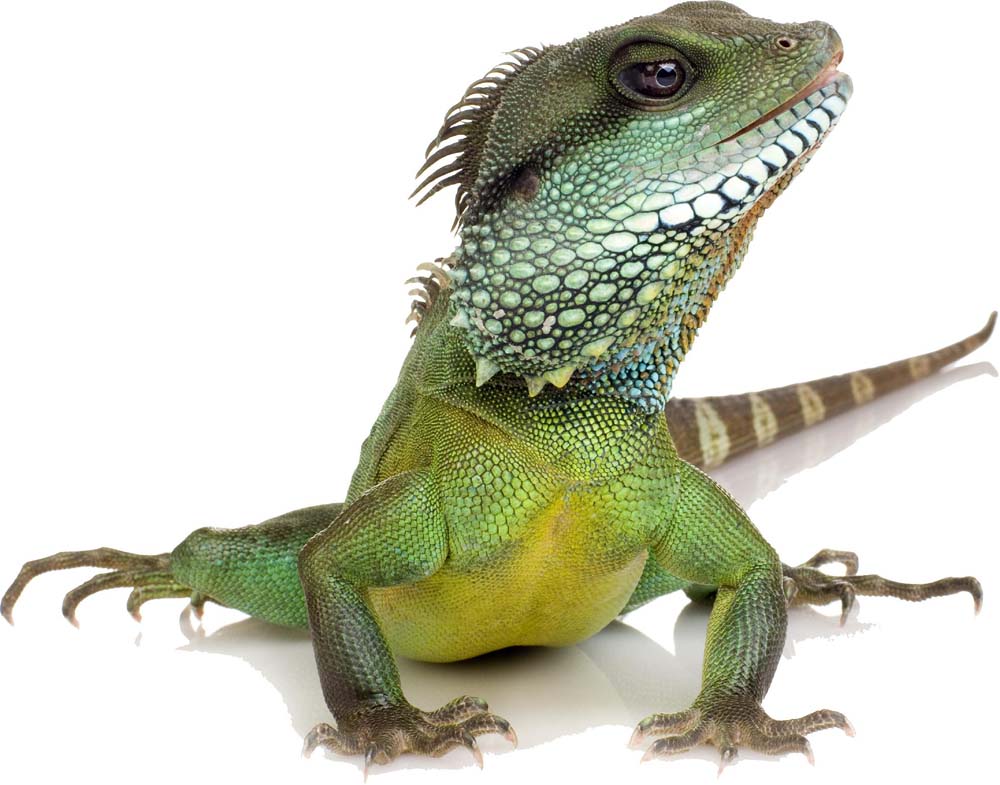
Sunday, February 10, 2002.
Our flight departed Miami about eleven in the morning and arrived in San Jose three hours later, one o'clock local time. Then the waiting began. We must have whiled away an hour and a half before all our tour members had been collected, 18 in total. Dozens of bags of luggage were strapped to the roof of a small bus that seats about 20, we climbed aboard, and headed off for a grand tour of the capital city.
Our guide, Edgar, is a real nice fellow; pleasant, sincere, devoted, and having spent time on a farm in Buffalo and in school in both New Jersey and Virginia, his English is pretty good. Some of his pronunciations, however, are pretty funny to Jim and me. And occasionally he'd butcher tenses, make up new word endings, and use a word that only sounded like the word he intended. This makes for colorful and comic moments. For example: "At that time the land was inhabitated by Indians." I've scattered a few "Edgar-isms," as I call them, throughout this journal.
We drove from the airport into San Jose and through the downtown section. The streets are well paved, but buildings are not in as good shape; paint is pealing, dirt is accumulating, and many storefronts are boarded up. It is a third world country, after all.
We visited the National Museum and spent much more time there than I wished -- the rest of the afternoon, as a matter of fact. The others seemed interested in the exhibits, but also grew weary of the lengthy tour, I thought. We spent so much time there, we didn't get a chance to visit the National Theater, Metropolitan Cathedral, or the home of former Costa Rica president Oscar Arias -- sightseeing highlights promoted in the tour itinerary.
We returned to our hotel, the San Jose Palacio, a little after 5:30. Dinner and an Edgar "briefing" began at 7:00. The principal instructions for this evening: re-pack only necessary things into the General Tours-provided back pack, place all other luggage outside our hotel room door by 6:30 a.m., get breakfast, and be ready for a 7 a.m. departure.
We did as told.

Monday, February 11, 2002.
Edgar-ism: "The highway was build-ed through the park."
Shortly after 7 o'clock we were all back in the bus and on our way northeast along Route 32 into the Braulio Carrillo National Park. We stopped once to gaze at a grand vista of mountains, forests, and clouds, then pulled off the highway a little before 9 a.m. onto a well-kept, bricked road that took us a mile or so into the forested terrain. We had arrived at the Rain Forest Aerial Tram. It's basically a sky lift, fitted with hanging, six-seat baskets that take riders first for a view of the floor of the forest, then after a 180 degree turn, back along the same course, but in the forest canopy. (Photo at right: View from the Rain Forest Aerial Tram.)
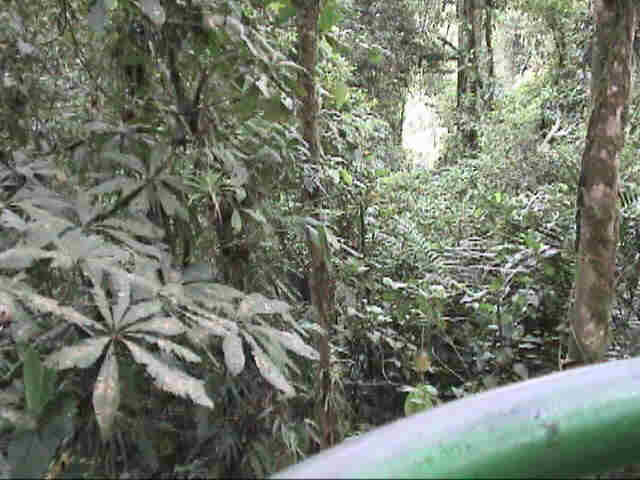
The ride was about three-quarters of an hour and was simply a delight. A guide accompanied us to point out unusual plants and trees and answer all our questions. Riding through the forest on a tram was a real thrill, but there were no animals -- like monkeys and parrots --to be seen. After the trip we were shown some huge ants running around on the ground near the tram, and a very colorful, though tiny, frog, called the blue jeans frog, because its rear legs are a vivid blue, while the rest of its body is a brilliant red.
Lunch, later, at a resort, was early, before 11:30. Quite good: tuna/pasta salad, chicken stuffed with ham and cheese, rice, vegetable medley (broccoli, cauliflower, carrots), with a tasty custard/cheese cake dish.
Back in the vehicle, we continued east along Route 4, then turned northeast at the city of Siquirres onto increasingly poorer and poorer roads until the road surface was merely rocks, gravel, and dirt. We traveled for miles through banana plantations, with occasional pineapple fields and cattle pastures in between.
At one spot the vehicle came to an abrupt stop, then backed up maybe fifty yards. "Sloth," Edgar announced, and sure enough, in a small stand of trees on the right side of the road, up near the top, was a sloth slowly moving along a branch.
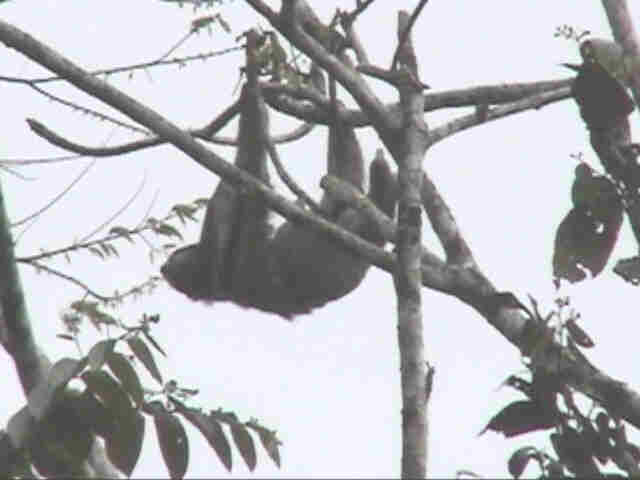
A three-toed sloth hangs upsidedown, as is his preference, in a tree along the road to Torruguero.
We all piled out to take pictures and watch the creature with binoculars. Then someone spotted a monkey. Then someone else saw a baby monkey with its mother. After a few moments examination, we counted one sloth and maybe a half dozen or more monkeys.
Shortly after the sighting we passed by a pasture of cattle. One cow had just given birth, and the new-born calf was still in its birth sack. Already delayed by the sloth sighting, however, we could afford no further delay and bumped on without any photos or proper gaping.
Our road ended alongside a river, in which a boat was waiting to taxi us north, along the Tortuguero Canals (an intra coastal waterway) to our destination for the evening, the Pachira Lodge. At some spots the land between the river and Caribbean was only a hundred yards wide. The boat trip took over an hour.
Just across from the lodge is the community of Tortuguero, apparently founded to oversee the protection of the sea turtles (thus the name), which uses the beach there as one of its major nesting locations. We saw a video at the turtle protection center, then walked along the black-sand beach, watched the Caribbean wash up on the shore, then strolled leisurely through the village before boarding our boat for the five-minute spin across the river to the lodge.
Upon arrival we were each presented with a glass of tasty fruit punch. A slice of star fruit adorned the rim.
Dinner was served at 7:00 and consisted of beef, chicken, mixed vegetables, salad, and a custard-like dessert. Once again: delicious. The cuisine is becoming a little predictable: the selections are pretty much the same for lunch and dinner.
We were allowed only a back pack worth of items while at this lodge, so we had to make a number of packing decisions the night before. Facilities were rather basic, but adequate. A restless sleep Sunday evening prompted both of us to go to bed early. Several heavy rainstorms passed by during the night.

Tuesday, February 12, 2002.
Edgar-ism: "This bunch of bananas will be ready to be cut-ed down soon."
Once again it was not a restful night for me -- disturbed by one or two heavy rainstorms that had passed through -- and I heard the steps of someone coming, before the 5 o'clock wake-up knock on our door. After juice and some cookies we boarded a topless boat for an early-morning, sunrise tour of nearby channels and waterways in the Tortuguero National Wildlife Park. Before we could begin, however, Edgar had to pay a government fee to use the park. We must have waited 20 minutes for the paperwork to be completed for our boat and several others lined up at the dock. It was a fine example of Tortuguero bureaucracy.
The ride was wonderful! Rays from the sunrise gradually illuminated the dense forest foliage, birds were singing their morning songs, and monkeys scampered playfully high up in the canopy. It was wonderful . . .
Until it began to rain . . . followed quickly by a downpour. This was not entirely unexpected, as we had been issued large slickers when we boarded the boat. We sat quietly as the rain doused us. We headed back to the lodge, arriving there in time for a quick shower and breakfast before returning to the dock to board our "taxi", which retraced yesterday afternoon's route back to where our bus awaited us.
By then we were behind schedule, so Edgar directed us to take our seats immediately. However, the long boat ride had its natural effect on the kidneys, so a pit stop was called for as soon as we reached the dock. A long line quickly formed at the latrine. We were advised that in spite of the fact the facilities were free yesterday, today a charge of 50 colones (only about 15 cents U.S.) was being assessed. Jim and I quickly decided that in the interest of time, we'd do our duty out behind the building. A number of others in our group had reached the same conclusion.
It was a long ride (back over the bumpy, bumpy roads), maybe an hour or more, to E.A.R.T.H. ("Escuela de Agricultura de la Region Tropical Humeda"), a university founded in 1990 and dedicated to "sustainable development." There we ate in the school cafeteria (beef, rice, vegetables, salad, ice cream). Afterwards we were led to a classroom where we saw a video that extolled the virtues of E.A.R.T.H. We were told the U.S. government had supplied $80 million for scholarships (your tax dollars at work).
Following the propaganda, we were taken to the E.A.R.T.H. banana "plantation," where the fruit (they don't grow on trees -- they're herbs, we were told) is grown organically. It was an interesting presentation to see how bananas are grown, harvested, and processed, and how banana byproducts (including toilet paper -- but I think they need a little more R&D here) are produced.
Back in the bus, it was another couple of hours before we reached our evening's destination: the Hotel Centro Neotropico Sarapiquis, overlooking the Tirimbina rainforest, not too far from Puerto Viejo. The rooms were built in three circles of eight with a tall, thatched, cone-shaped roof over each grouping. The registration desk, dining room, and bar were also nestled under a similar thatched construction. It was rustic, but very comfortable.
After dinner (fish, rice and beans, mixed vegetables, salad, chocolate cake), Jim and I turned off the lights in our room (in hopes the bugs would go elsewhere -- although there really weren't very many of them) and reminisced about the trip's events, before falling off to sleep.

Wednesday, February 13, 2002.
Edgar-ism: "This volcano has an average age of a million years ago."
We decided to forego the early-morning (5 a.m.) bird-watching hike with Edgar (those who went on the walk were disappointed with the wildlife they saw) and set our alarms for 6:45. We were at breakfast at 7:30, and a half hour later just Jim and I were in the bus headed for the Saripiqui River and a river boat ride. Edgar accompanied us. Most of the others selected white-water river rafting as the morning activity.
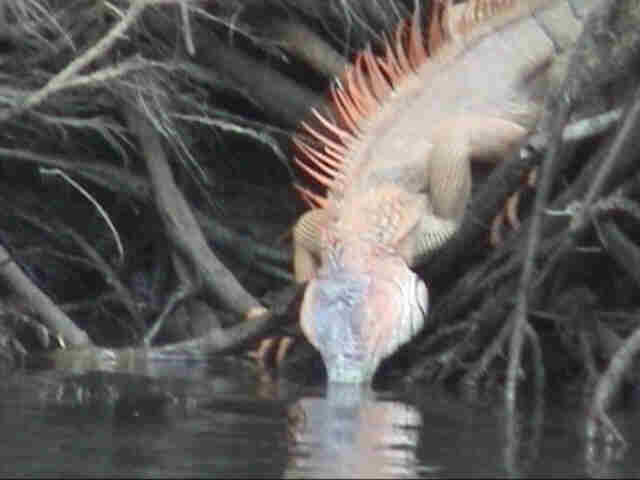
An iguana sips at the edge of the Saripiqui River.
The day was magnificent: temperature in the low 70s, pleasant breeze, clear blue sky, low humidity, and we were fully rested! We had the whole boat (maybe 30 seats) to ourselves, and the "captain" lazily guided the craft first up the river, then down. Occasionally he'd turn off the engine and we'd just drift along with the current. It was glorious! (Photo at right: An iguana sips at the edge of the Saripiqui River.)
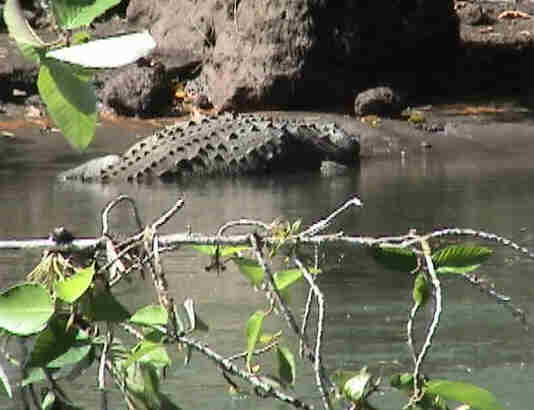
A crocodile suns itself along the Saripiqui RIver.
We saw howler monkeys (a dozen or two), a number of iguanas, a two-toed sloth (much more rare than the three-toed variety we had seen on Monday), a caiman, and two crocodiles (one 10 or 12 feet long, the other a baby, just six or eight feet long). (Photo at left: A crocodile suns itself along the Saripiqui River.)
Also, the shapes and patterns along the river were delightful to see: twisted roots of fallen trees; lush foliage; interesting erosion patterns in the black sand banks, like terraced gardens; falling leaves shaken from their perches by energetic monkeys; the intermingling of sunlight and shade. It was a grand experience.
Back at the lodge, we had a brief walk around the grounds, prepared for our departure, had lunch, and at two o'clock headed on to our next destination.
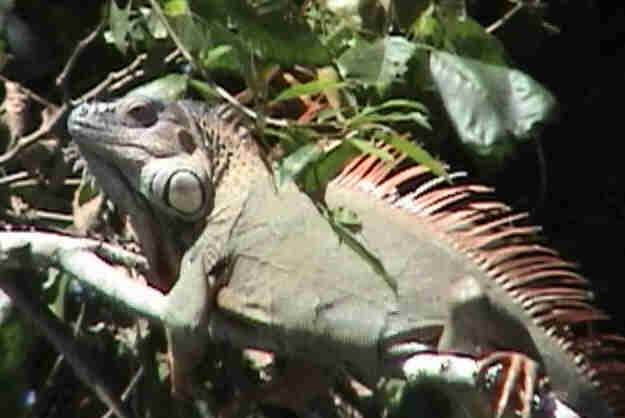
An iguana next to where we had lunch.
We stopped at a roadside refreshment place in a small town for a potty break after an hour or so. As an added feature, there were at least a dozen big iguanas roaming about on the ground next to the building, and riding gracefully on nearby tree branches swaying in the sometimes brisk breeze. (Photo at left: An iguana right next to where we had lunch.)
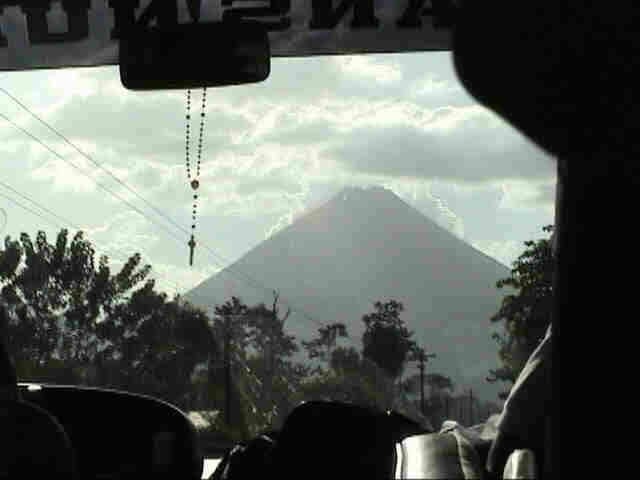
The Arenal Volcano seen through the windshield of our bus.
The first glimpse of the Arenal Volcano was from many miles away. It appeared as a barely-discernable shape -- just a shade of gray -- like an enormous pyramid off in the distance. As we neared the volcano, we could see all of it -- a rare occurrence, according to Edgar -- because it is usually shrouded in clouds and/or haze. We approached from the east, and as we got closer, we observed the surface was covered with greenery. Traveling around the base, however, we found the northwestern face was barren; it was the side where lava flows stream down the mountain. (Photo at right: The Arenal Volcano seen through the windshield of our bus.)
We got out of the our bus to take pictures. The peak was spewing forth plumes of steam, gasses, and debris. The volcano was erupting, but with rather meager displays. We saw material tumbling slowly down the mountainside, steam shooting from vents at several locations, and periodic puffs of what looked like white smoke issuing forth from the crater. It was thrilling to watch. But, surprisingly, we could near no sound at all.
After arriving at the Hotel Tabacon Resort Lodge and getting our room assignments, we walked the quarter mile or so down the hill to the Hot Springs Spa at Tabacon, where we received towels and locker assignments. Spring water heated by the volcano flows right through the spa, spilling into and out of pools and tubs and ponds. The thermal waters flow over waterfalls and along all sorts of man-made channels and waterways.
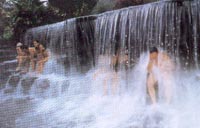
Sitting in a thermal waterfall is absolutely glorious. (Photo: Internet.)
In our bathing suits, we lavished in one hot pool after another, as the sun sunk over the horizon. Some pools were very hot, others were cooler, but all were delightful. The best of all spots was directly under a waterfall maybe 20 feet wide. It was constructed so you could sit on a ledge and let a never-ending stream of hot water tumble down upon you. You could also lean back through the waterfall into a cavity behind the curtain of water. It was a unique and most pleasurable experience.
Our thermal romp was cut short, however, as we had to gather with the other tour members for supper at 7:30. Had we been allowed, we would have soaked until we looked like red prunes.
The supper buffet consisted of steak, rice, mixed vegetables, salad, fruit, rolls, and a selection from maybe a half-dozen different cake-like desserts. After eating, we were anxious to see the volcano's eruptions of red-hot debris and its glowing ashes tumble down the sides of the mountain, but as the evening descended, so did a heavy cloud cover, and the "perfect" view we had from our lodge room of the volcano was completely blocked. We couldn't see Arenal at all.

Thursday, February 14, 2002 (Happy Valentines Day.)
Edgar-ism: "The lake is a wild life refugee."
There were some volcano rumbles during the night -- actually they're more like "booms" -- but I slept through them. Several members of our group did hear them, however. I heard a couple in the early evening yesterday and during the morning today.
After 7:30 breakfast, we met at the reception desk for our chosen activity. Jim chose a walk around the base of a volcano and I chose a horse-back ride followed by a swim in a large pool at the base of an exquisite waterfall.
It was a maybe 15-minute drive to the stable. My horse was named Cicero. After climbing aboard, I had a heart-to-heart conversation with the animal. I explained that I'd go easy on him, if he reciprocated in kind. Right from the beginning we reached a meeting of the minds. I patted him approvingly on the neck. Neither of us broke our pledge.
It was a delightful, easy ride up the mountain along a mostly dirt, but sometimes rocky road. With the slightest nudge of the rein to the left, Cicero would edge to the port side. With a gentle nudge of my heals in Cicero's stomach, he'd accelerate just a little. After a while I thought that the rough rope, which was Cicero's rein, might be chaffing his neck, so I used both hands to keep it from rubbing. Cicero and I were on the same wavelength.
The ride was only about a half hour. There were rest rooms where we dismounted, and we used them to put on our bathing suits under our other clothing. Then we descended down a narrow and sometimes steep path to the bottom of a gorgeous 135-foot waterfall, the Fortuna Waterfall, and a pool maybe 50 yards in diameter.
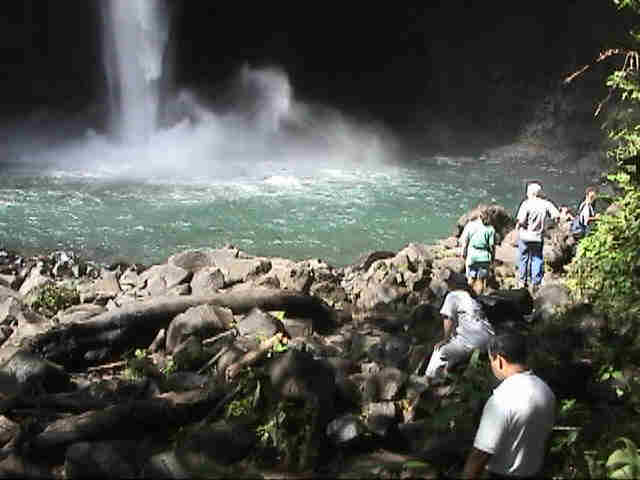
Fortuna Waterfall. Com on in, the water's great!
Water was plunging so forcefully into the pool it made a circular pattern of waves and created quiet a current. Several members of our party tried to get close to the splash-down point, but couldn't because of the current. The water was cold, but not bitter cold. After the decent, it was refreshing and thoroughly invigorating.
After maybe a half hour we retraced our steps back up the steps to where the bus was waiting for us. It was a grand morning. We got back to the hotel shortly before noon.
We ate lunch (this time: spaghetti! and it was delicious!) at the spa, and then had just enough time to take some pictures before our bus departed at 2:30.
Even though the Hotel Montaña Monteverde is less than 15 miles (as the toucan flies) from the spa, it took us four hours to get there! We had to go half way around a 27-mile long reservoir, Lake Arenal, and the roads were atrocious. They were gravel, but with endless ruts, holes, and large rocks, they made a real obstacle course. We learned there is a shorter route, but the roads are even worse that way; so bad only four-wheel-drive vehicles can get through.
Along the route we stopped briefly to take pictures of a coati (a raccoon-sized animal) that was begging, successfully, for food from a willing tourist.
On our way again, we encountered a section of the road in the right lane that had been undercut by erosion and was washed out. Only one small barrier marked the spot. I shudder to think what would have happened if our bus got too close to the edge. The drop off was steep and a long one, and no walls or barriers offered protection for poor drivers. Fortunately, our driver, Minor, was very cautious. We felt quite comfortable with him at the wheel.
Some distance into our trip we heard a loud thumping sound. A fan belt had shredded. Fortunately, it was the belt that powers the air conditioning, and since we had climbed in altitude several thousand feet, the outside temperature had cooled making the AC unnecessary. The stop for "repairs" (actually, just cutting away the frayed belt) took no more than 10 minutes or so.
As we got to higher and higher elevations, we saw several windmill farms. At these altitudes, the winds are strong and steady, so electrical generating via wind energy is utilized. The immense towers with their enormous rotating propellers are quite an eyesore. And they make a terrible racket!
The sun had set by the time we arrived at the lodge. Too bad; a photo of the sunset right from the front door of our room would have been beautiful. Dinner (beef, rice, mixed vegetables, soup, and cake) was served at 7:00. We made preparations for the next day's activities, then headed to bed, though I did take time for some journal entries.

Friday, February 15, 2002.
Edgar-ism: "I'm so sensible to temperature changers."
Last night Jim and I set our alarm clocks for 5:30, since we had to be showered, shaved, shampooed, and ready for breakfast at 6:30. Jim's alarm went off first. He got up, went in the bathroom and got in the shower. I assumed my alarm would sound a few minutes later, but when it didn't, I pressed the button to light up the face of my timepiece. It said 4:35. To make a long story short, Jim had set his alarm to ring based on Eastern time, an hour earlier than Costa Rica time. He was not a happy camper when he discovered his time-zone mixup and jumped back in bed after his shower.
The shower head in our bathroom had an unusual feature. When you tried to adjust the direction of flow, the head and neck came right out of the wall! The good news was that you could jam it back in the hole and continue your shower. (I later reported the problem and it was fixed during the day.)
We boarded the bus at 7:15 and headed for the Santa Elena Cloud Forest Reserve. Our fees were paid by Edgar and our three-hour hike in the cloud forest began. And so did the rain. Fortunately, I had my umbrella with me to keep my new video camera dry, but taking videos while trying to hold onto an umbrella is not recommended for optimum results.
The path was narrow and the forest is lush and dense. I bumped into things because the umbrella blocked my view, and occasionally I slipped and tripped over the slices of logs used for steps on the path. Just about the time I was getting the hang of things, the video tape ran out. Since it's a new camera, I wasn't sure how to change tapes, and the middle of a cloud forest with light rain and occasional strong gusts of wind is not the place to learn. Particularly when you need to "keep up with the group." Fortunately, I figured it out, got a new tape installed, and continued videoing.
For a portion of our hike we walked along the Costa Rica continental divide. Then Edgar led us to a spot called "the window." It's an observation point where, on a clear day, one can see both the Pacific Ocean to the west and the Caribbean to the east. Today we couldn't see more than a couple hundred feet. The winds were so intense and turbulent, they turned my umbrella inside out. Twice! I thought I might do a little involuntary parasailing right off the continental divide.
At the end of our hike we were drenched and wind blown. Edgar provided a perfect summary of the morning's activity: "This is the dry season . . . and we're wet!" Dressed in a T-shirt and no sweater, jacket, or raincoat, he was obviously not expecting the precipitation. Several of us suspected he caught a cold during the walk because he later seemed to be wrestling with a mild case of laryngitis.
We returned to the lodge for lunch, then at 2:30 departed for the Monteverde Cloud Forest Sky Walk and Sky Trek. Eight of us, including Jim and me, took the former, and most of the rest took the latter.
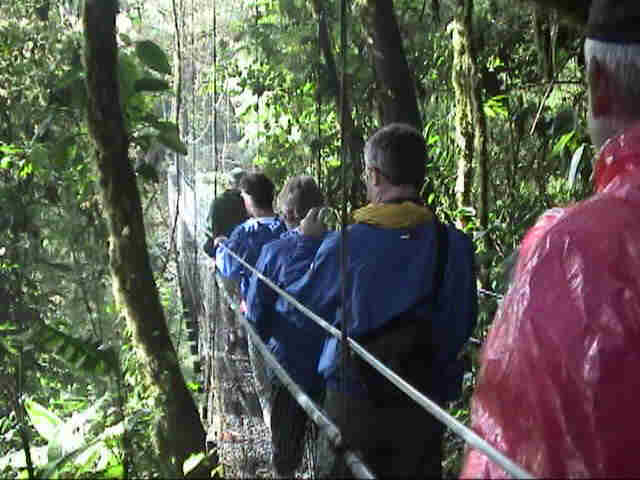
One of the six suspension bridgges encountered during the Forest Sky Walk.
The walk was another pathway through the cloud forest, but on a route that took us over six long, suspended bridges (no more than ten people are allowed on a bridge at the same time). Some bridges seemed to be under repair -- not a particularly comforting realization.
Although our hike started with high wind gusts and mist and rain, it concluded with bright sunshine. It was a fun trip and lasted about two hours. On the bridges, we were at times as high as 150 feet above the forest floor. Exciting! Especially when a bridge starts swaying back and forth. Especially when the bridges are as long as 656 feet! (Most were 300 to 400 feet long.)
We didn't get back to the lodge until 6:30. Dinner was at 7:00.

Saturday, February 16, 2002.
Edgar-ism: "For supper you don't need to dress for successor."
The bus departed the lodge at 8:45. A half hour later we arrived at the Jardin De Mariposas Monteverde Butterfly Garden. I braced myself for two hours of boring descriptions, endless butterfly names -- in Latin, of course -- and searches in one or more gardens for all varieties of uninteresting lepidoptera.
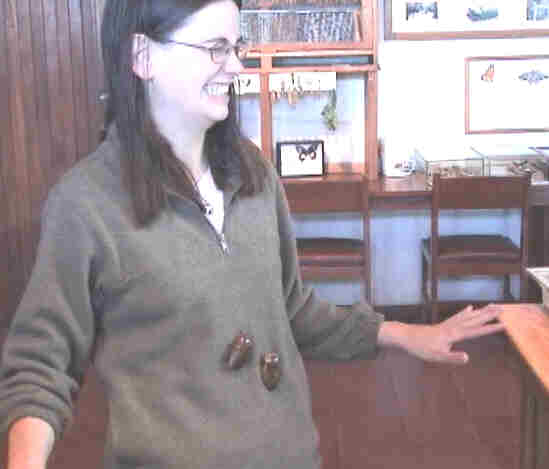
Two huge cockroaches cling to our guide's sweater as she tells us about some of the inhabitants at the butterfly lab.
I was dead wrong. Our guide was perky and smart, and gave us a thoroughly interesting and informative talk on the subject of not only butterflies, but all insects in general.
She showed us a bunch of live bugs, beetles, and creepy-crawly things that live in glass containers in the on-site lab, including cockroaches (they're cleaner than the inside of your mouth, she said, and they can readily withstand two hours in a microwave oven and two days frozen solid), bugs which have been used for anti-histamine purposes (she ate one!), jewel scarab bugs (they looked like they had been chrome plated), walking sticks, a tarantula, wasps, scorpions, and much more. I was taking video all over the place. It was absolutely fascinating!
She then led us outdoors through four enclosed "gardens" where temperature conditions are controlled to simulate different altitudes, and she showed us the butterflies that inhabit each. The two-hour tour was a treat.
Back on the bus we proceeded southwest to the Pan-American Highway, then northwest toward Liberia. At about 1:30 we stopped for lunch at La Pacifica Restaurant and several hours later arrived at the Melia Playa Conchal Beach and Golf Resort at Guanacastle about 5:00. The resort is spread out over a huge area and includes a beautiful "white" sandy beach (I've seen whiter) on the Pacific Ocean. It also includes a convention center, casino, discotheque, and of course an 18-hole golf course.
The rooms are luxurious: double-door entry; tiled floor; two columns flanking the two steps up to the sleeping area (which contains two double beds); marble bathroom and shower area, separated by a thick glass door; a hot tub; and a 50-inch flat-panel TV. (Well, actually, I lied about the hot tub and big TV.) I figure our room had about 500 square feet of space.
Four rooms (two on the first floor, two on the second) form half of a "bungalow" and are accessible from a "street" that runs right in front of the units. The other four are accessible from the adjacent street. The landscaping between buildings is lush and beautiful.
The beach area contains a magnificent (and humongous) free-form pool, a half-dozen restaurants and food stands, a game area, a little "band stand," and lots of palms and tropical plants. The place is really first class, as nice as any U.S. resort.
But my mood was not cheery and upbeat, as it should have been. Jim and I were told our luggage would be delivered to our room, but we noticed other tour members had taken their luggage with them. When we were shown our room by the driver of the "mini-bus" that transported us from the reception area, we told him we needed our bags. He said he'd retrieve them for us immediately.
We waited 10 minutes, then 15. No bags. Thirty minutes went by; still no bags. After three quarters of an hour, we decided to go back to reception to find out what went wrong. We explained our plight to a mini-bus driver who happened by, and he radioed for help.
It seems the bags had been placed in storage. Fortunately, they were retrieved and waiting for us when we get back to the check-in desk at the reception building. The "lost" was "found," but nearly a precious hour had been lost in the meantime.
By then it was dark and we had missed a nice sunset. As the meals to date have been quite filling, we thought we'd forego a big meal and we made due with a 10-inch pizza that we split between us. It was darn good.

Sunday, February 17, 2002.
Edgar-ism: "The coffee yield is brought-ed to the mill."
The weather could hardly be any nicer: bright sun, pleasant breeze, temperature in the mid-90s. Perhaps best of all, we were able to sleep in! There were no bags to pack, deadlines to meet, or early-morning departures. The entire day is free. We're on our own.
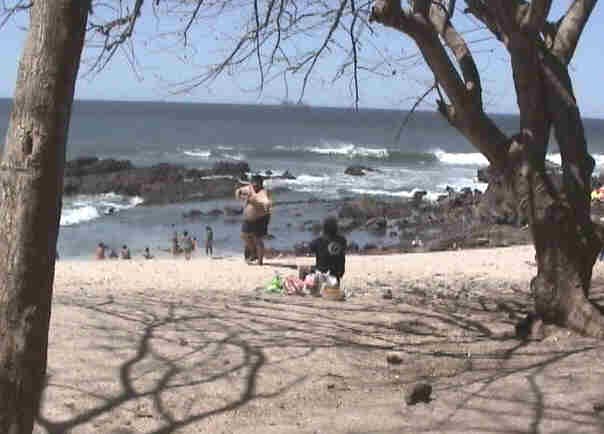
The Melia Playa Conchal Beach and Golf Resort sits right on a protected section of the Pacific Ocean.
We got up at 8:00, showered, dressed, leisurely ate breakfast at the Mitra Restaurant, and the next thing we knew it was 11:00! We wanted photos of the resort, so we took pictures of the reception area, our room, then the pool and beach area.
By mid-afternoon we surmised the peak heat of the day had subsided, so we headed for the pool and splashed about for some time. I wanted to take a swim in the ocean, so we headed for the beach. I got in up to my neck, but the waves were rolling in with such force, I was concerned about a strong undertow or rip tide, so my "swim" was abbreviated.
No one else was in the water where Jim and I were, and we wondered if the other swimmers knew something we didn't. A man and woman entered the water just as we were about to leave, and they didn't have any trouble, but the force of the waves coming ashore and then racing back was very powerful.
Most of our group met for dinner at the Steakhouse Restaurant at 7:00. I had lamb chops -- yum! We ate and talked until 9:30.

Monday, February 18, 2002.
Edgar-ism: "It's protected for scientific researches."
We understood our bags were to be placed outside our rooms before 8:30 a.m., but with the luggage difficulties we had upon arrival at the Playa Conchal, we decided to take our things to the reception area ourselves. We got there a little before 8:00. Jim realized he had left his new cap, purchased at the Tabacon Lodge, in the room, but I figured we could stop by and pick it up on the way to or from breakfast.
We were unable to check out because our mini-bar purchase Sunday had not been accounted for. A "mini-bar man" was dispatched to our room to check how many drinks we had used (it was only one).
Meanwhile, we decided to catch a mini-bus to the restaurant for breakfast. I gobbled up my omlet and fruits and downed my pineapple/mango "smoothee" (made to order, no less) and walked back to our room to retrieve Jim's cap.
It was not there. I searched high and low. Assuming Jim had packed it and forgot about doing so, I walked to Reception. I retrieved our bags from storage and saw to it they were loaded on our bus, then waited in line to complete the check-out process. I was rather ticked that an amount of 345 colones (a buck, U.S.), a "donation to the rain forest", had been added to our bill without our permission.
Jim arrived at Reception and looked in his bag. No cap. The check-out lines were not long, but they were slow, very slow. At our 9 o'clock departure time, I was still dealing with paperwork.
After we departed the resort, I concluded that the only plausible explanation for the missing cap was that the "mini-bar man" stole it. He seems to be the only one who entered our room from the time we exited with our bags until the time I re-entered to retrieve the cap.
Today was mostly a travel day. We retraced our steps to the Pan-American Highway and south toward San Jose, then stopped for a light lunch around 1:00 at a road-side restaurant. It served local cuisine in an open-air (read: hot), but roofed, setting. We then continued south, but pulled off the highway to visit a souvenir shop in Sarchi, which is only 10 miles or so from our evening's destination, the Resort Martino Hotel & Med-Spa.
At 7:30 we gathered for our final, farewell dinner (lasagne! although sea bass was an option). There was much gaiety, as the members of the tour had gotten to know one another and become friends. Speeches were made expressing thanks to Edgar and Minor and acknowledging what a grand tour it had been. There was unanimity on both points.

Tuesday, February 19, 2002.
Edgar-ism: "Here they do coffee farmering."
Both of us were awake before the alarm clocks sounded. Our bags were outside the door and we were at breakfast before 7:00. By 7:45 we were on our way. This is the last day in Costa Rica for all but a couple of the tour members.
Our first stop was the Doka Estate coffee plantation. It was a beautiful sight with all the rich, green coffee plants neatly lined up on the hilly terrain. Edgar showed us the red, ripe coffee berry -- he called it the "cherry" -- and invited us to taste the sweet fleshy pulp that surrounds the bean. He explained how coffee is grown, harvested, and processed. It was an informative and pleasantly brief presentation.
Briefness was goodness as we wanted ample time to see the Poas Volcano before heading to the airport for our departures.
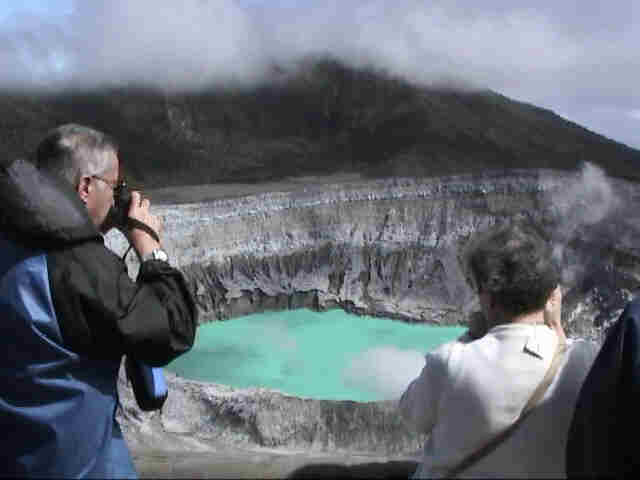
The Poas Volcano.
The volcano was spectacular. We were able to walk up to the edge and peer down into the crater. A number of fumaroles were issuing forth plumes of steam. It's a live volcano. At the very bottom was a good-sized green-white lake, colored with high concentrations of sulfur that the volcano produces. You could get occasional whiffs of the chemical. Edgar said the lake has a ph reading of one! Wow, if the temperature doesn't get you the acid will!
There wasn't enough time to linger there, but I think we all got some good pictures. Next, we hiked maybe a quarter mile to a second crater, located above the first. This one was inactive. It contained a conventional-looking lake significantly larger than the Poas lake.
The hike wasn't particularly challenging from a terrain standpoint -- there were steps and inclined pathways -- but at an altitude of 9000 feet, it was not easy. Several of us were huffing and puffing when we reached the vantage point at the end of the trail. Happily, the walk back to our bus was much easier.
On the way to the airport we passed some stunning views of the surrounding scenery: changing patterns of coffee fields, clouds hugging the tops of distant mountains, children in their school uniforms -- many with backpacks over their shoulders -- walking along the road, lush greenery, brilliant sun. It was hard to believe that in just a matter of hours we'd be jetting to Miami, and the entire Costa Rica adventure would be just a memory.
Well, not really. I have my scribbled notes of our experience and 90 minutes of video. And the recollections will be with me forever.
It was a grand tour of Costa Rica, with a knowledgeable, pleasant, and accommodating guide; a skilled driver; and a bus full of interesting and friendly people. We got drenched in a rainstorm together, bounced around in our bus on endless brutal roads together, marched up mountains together, swam in the luxurious Playa Conchal pool together, and we all had a glorious time.
And not only that; I returned home without any ant-attack incidents or bothersome bug bites, like I collected on my trip last year to Manaus, Brazil!
So, where should we all go next year?
 The way back home. The way back home.
|












